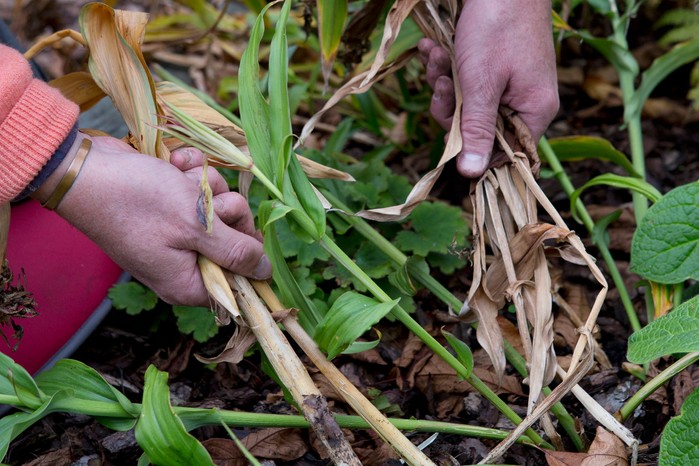
Autumn is the ideal time to give your garden a thorough tidy, before the cold weather sets in.
As well as clearing fallen leaves, there are lots of other simple tasks that will make a big difference to the look of your garden.
Don’t forget your garden’s wildlife – discover four essential autumn jobs for wildlife.
It’s worth putting in a little extra time and effort now, so your garden will look neat and well-tended through the winter months – it will also mean that you’ve got a head start next spring.
Tidy your borders
Tidying the garden – clearing dead leaves and stems from a border by hand
Remove dying leaves and collapsed stems from herbaceous perennials, either pulling by hand or cutting at the base with secateurs. Leave any stems that have attractive seedheads for birds to enjoy. Remove weeds, then spread compost or well rotted manure over the soil to insulate plant roots – the worms will work it in over winter.
Collect autumn leaves

Tidying the garden – gathering brown, fallen oak leaves with an extended metal grabber
A few piles of leaves in out-of-the-way places – under hedges, for example – can provide shelter for overwintering wildlife. But remove leaves from your lawn, paths (which can be slippery) and borders. Use them to make leaf mould, a great soil improver.
Autumn leaves fall in huge quantities during October and November, quickly covering lawns and borders. Left in place they can smother grass and fill the crowns of herbaceous perennials, sometimes killing them. In this short video guide, Alan Titchmarsh demonstrates how to quickly rake up fallen leaves without damaging your plants. He explains why this needs to be done and shares advice on turning your harvest into soil-conditioning leaf mould:
Clear away old crops

Tidying the garden – snipping the base of a dead stem with secateurs
Clear spent plants on the veg plot before they start to rot and become host to pests and diseases. Compost everything unless it’s diseased. Chop beans and peas off at ground level, leaving their nitrogen-fixing roots in the soil to feed next year’s crops. You could also sow a green manure, a great soil improver.
Leave your lawn looking trim

Tidying the garden – trimming the edge of a lawn beside a path with an edging knife
Nothing sets off borders better that a neatly cut and edged lawn, so mow for the final time. Set your mower blades higher than usual to leave the grass slightly longer over winter, then cut the edges with an edging tool or knife to redefine their pristine lines.
Put away plant supports

Removing old runner bean stems from a cane wigwam support
Cut down annual climbers in borders and climbing beans in veg plots and remove the dead stems and foliage from their supports. With canes and other removable wooden supports, wash off any soil then treat them with preservative. Store them indoors over winter.
Make repairs

Tidying the garden – re-spraying a weathered garden fence with blue wood preservative
Repair damage to raised beds, sheds and compost bins, and paint them with wood preservative. Replace any rotting fence posts, so they don’t get blown down in winter storms. Ensure shed roofs don’t leak, and replace any broken panes or faulty vents in greenhouses.
Clean out nest boxes and feeders

Tidying the garden – scrubbing inside a wire mesh bird feeder with a soapy bottle brush
Take down bird boxes and empty them. Old nesting material, unfertilised eggs and other debris may carry diseases, so wash out the boxes with hot water before putting them back. Also remember to clean out feeders and bird baths, and regularly refill them.
Sort out your pond

Tidying the garden – scooping fallen leaves from a garden pond with a net
Scoop out leaves that have blown into your pond, before they sink down and start to rot. Also cut back the foliage of marginal pond plants that have died down. Remove pond pumps and fountains that are no longer in use. Wash them out thoroughly, then store over winter.
